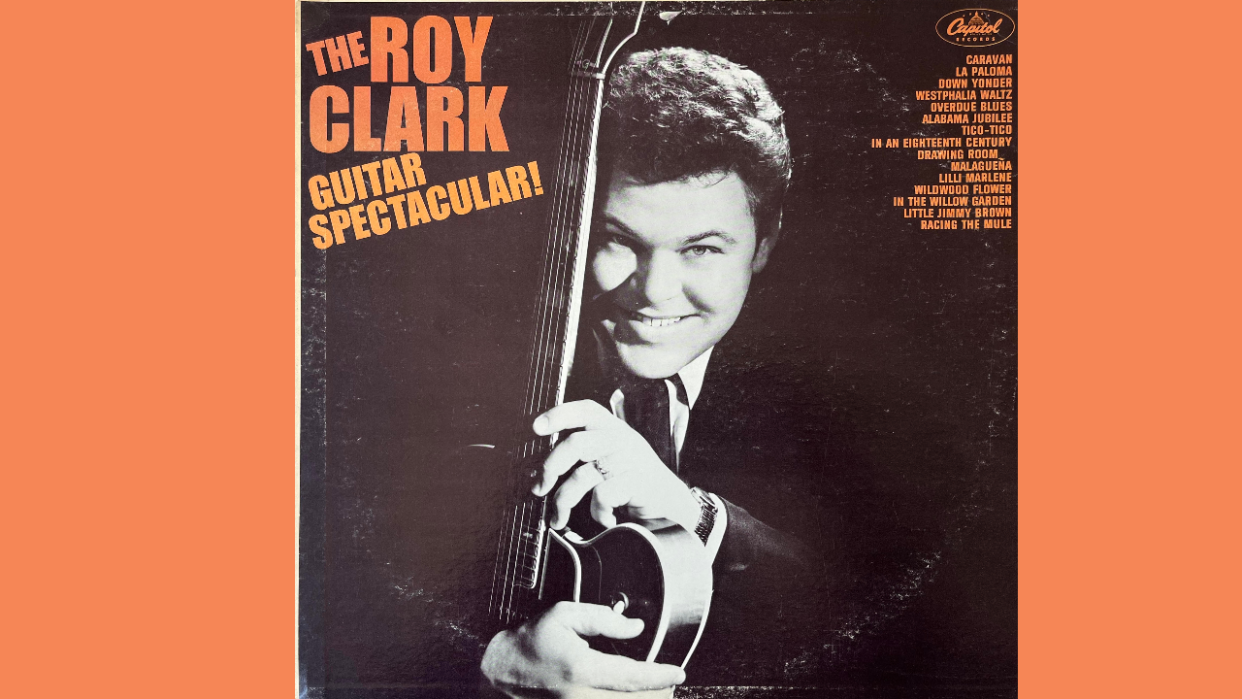From sparkling duets with Joe Pass to sweat-soaked virtuoso TV guest spots, his playing was a wonder — here’s why you should take a deep dive into The Roy Clark Guitar Spectacular!

Once upon a time, as I watched Roy Clark performing “Malague?a” on TV, I thought to myself, Sheesh! This guy is sweating buckets. Is sweating a part of his act?
Years later, I learned that “that guy from Hee Haw,” as I knew Roy, was a great multi-instrumentalist. He even made a guitar duet record with Joe Pass. So when I found Guitar Spectacular, I bought it. As it turns out, it’s a great place to start appreciating Roy Clark for the artist he could be.
I’m always pleased to re-evaluate an artist who I consider “commercial.” For example, many people think of Jerry Reed as Cledus Snow in Smokey and the Bandit, but Mr. Reed was actually one of the great guitar composers of the 20th century. Similarly, Roy Clark was more then a hokey main player on Hee Haw, as Guitar Spectacular readily proves.
Roy’s fourth record as a solo artist, Guitar Spectacular was released on Capitol Records in 1965, when he was 32. It’s my favorite of his albums (with all due respect to 1963’s The Lightning Fingers of Roy Clark), and I learned many songs from it that I still play today.
Side one opens with “Caravan,” which employs an infectious jungle drumbeat before swinging hard in the B section. Roy rips over this entire track. When I play “Caravan,” I use the Chet & Les two-beat on the A section and always swing the B section, Roy Clark style.
Roy had a tremendous right hand and his 64th notes are clean and seemingly effortless. He also plays jaw-dropping muted 128th notes on “Caravan” as a percussive statement. I’ve never heard anything like it.
The south-of-the-border feel that follows on “La Paloma” sounds more manufactured than inspired, but Roy injects life with grace notes and fire.
“Down Yonder” has a New Orleans jazz feel, with Roy playing lead lines reminiscent of Joe Maphis. Ripping over the dominant-7th changes, he owns it.
“Westphalia” is up next, with a hard waltz feel. I always appreciate records from this era, where a waltz was mandatory and a part of the instrumental repertoire. Roy testifies with authority on the smokey “Overdue Blues,” and I can’t help imagining his clean hollowbody electric sound — I’m guessing a Gibson Byrdland through a cleansounding Fender Twin — replaced by a Telecaster through a cranked Fender Deluxe. I bet it would sound like Danny Gatton.
“Alabama Jubilee” closes the side with an uptempo toe-tapper showcasing more of Roy’s flash guitar.
“Tico Tico” opens side two and is another arrangement I’ve adopted. The technical gymnastics of Roy’s breakneck playing transcend the somewhat corny backing track.
“In an Eighteenth Century Drawing Room” begins with solo classical guitar before going into a happy swing rendition. The aforementioned “Malague?a” is included as a solo guitar piece, and while it’s not my favorite, it was apparently a people pleaser and a show stopper when performed live.
“Lilli Marlene” follows as a break in the action, where Roy plays the melody with feeling and the phrasing of a master craftsman. A medley that includes “Wildwood Flower” serves as a flatpicking showcase and leads to the album closer, “Racing the Mule.”
Lest anyone forget Roy can shred, “Racing the Mule” is a potent reminder. His virtuosity can’t be denied
Lest anyone forget Roy can shred, “Racing the Mule” is a potent reminder. His virtuosity can’t be denied.
Although I love this LP, it might be pushing it for some listeners. It’s very commercial and at times borders on cheesy. And yet, I learned many significant arrangements and techniques from it, and if Roy Clark broke out in a sweat making Guitar Spectacular, it’s totally fine by me. I would be sweating too.
Leo Fender once said, “Roy Clark — he plays the guitar the way a guitar should be played.” I agree. Roy was one helluva guitar player.
The Best of Roy Clark is available to buy and stream now
